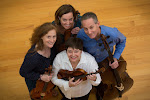Fast forward, um, a lot of years, and here I am, getting ready to play the Op. 132 String Quartet in a minor with SSQ, this weekend at the University of Delaware, the first late quartet I will have performed. The interesting thing: I'm still fascinated, confounded, moved, and terribly intimidated by this music. When I was a student at the Kneisel Hall Chamber Music Festival, at the ripe old age of 20, I had expressed my late-Beethoven fears to Ron Copes, who is currently the 2nd violinist of the Juilliard String Quartet and was my chamber music coach at the time. His advice to me: "Don't be scared, dig in!" He said that this music will always be challenging and difficult, and never completely understood, so play it early and often. Did I listen to this sage advice? D'oh!
I guess I have some catching up to do. And I'm excited to get started on my late journey with my wonderful Serafin colleagues. Op. 132 is an expansive work of over 45 minutes, consisting of five movements in a kind of arch form. The outer movements are big, driven and intense. The 2nd and 4th movements are stylized versions of popular older forms (the 2nd being a minuet of sorts, and the 4th actually titled "Alla marcia", or "like a march"), with unusual twists and turns, particularly in the presentation of meter and rhythm. But where this work draws its greatest power is the central slow movement, which is, without exaggeration, one of the most moving musical utterances ever created. The full title, believe it or not, is "A Convalescent's Holy Song of Thanksgiving to the Divinity, in the Lydian Mode". The Lydian mode is one of the ancient "church" modes, a way of organizing music harmonically and melodically back in the Medieval and Renaissance eras of music, before the advent of major and minor scales and keys. So this music, while reaching out to the divine, also reaches back in time. The third movement, often referred to simply as "Heiliger Dankgesang", is by far the largest of the entire quartet, and reflects Beethoven's thanks and renewed energy having been gravely ill in prior months. Whatever one's view is of the Divine, it is most certainly touched in this moment.
Here's a sampling of the movement, performed by the Stradivari Quartet:
So, if you're around Newark, Delaware on Sunday (March 10th, 3:00 PM, Gore Recital Hall at the University of Delaware), come hear us as we journey together through my inaugural Late Beethoven Quartet performance. We hope to make you fascinated, confounded and moved, too. (but don't be intimidated!)
Cheers,
Larry
